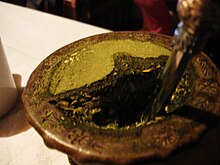
Brazilian tea culture has its origins in the infused beverages, or chás (Portuguese pronunciation: [ˈʃas]), made by the indigenous cultures of the Amazon and the Río de la Plata basins. It has evolved since the Portuguese colonial period to include imported varieties and tea-drinking customs.
There is a popular belief in Brazil that Brazilians, especially the urban ones, have a greater taste for using sugar in teas than in other cultures accustomed to unsweetened drinks.
During the colonial era, imported tea varieties were first cultivated in Brazil in 1812. Throughout the 19th century, the tea industry, much like the coffee industry, was heavily dependent on slave labor to work on the plantations.
When slavery was abolished in 1888, the tea trade collapsed. In the 1920s, the tea industry was revived by Japanese immigrants, who introduced tea seeds from Sri Lanka and India. Prior to this time, only Chinese tea varieties had been grown in Brazil.[1]
Brazil's largest tea-producing region is near Registro, a coastal city near São Paulo. Registro is in the Brazilian Highlands and forms a terrain of low rolling hills that are ideal for mechanized tea production. The growing season in Brazil is from September to April; the climate is hot and humid.
The relatively low altitude of most of Brazil's tea plantations, however, produces a tea which is less flavorful than high altitude teas. For this reason, Brazilian teas are most often produced for blending. The tea is used for both iced tea and hot tea blends with about 70% of the total tea production being sold to the United States.[2]
- ^ "Tea from Brazil". Tea Genius. Archived from the original on May 6, 2009. Retrieved October 23, 2011.
- ^ "Tea from Brazil". Tea Genius. Archived from the original on May 6, 2009. Retrieved October 23, 2011.